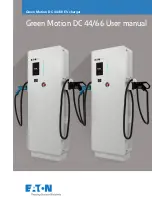
STUDER Innotec
Xtender
20 V.3.1.0
User
manual
precise sine wave. Any unit designed for the 230 V/50 Hz electrical grid may connect to it without
any problem, up to the rated power out of your Xtender. The inverter is protected against
overloads and short-circuits.
Thanks to the largely over-dimensioned performance level, loads of up to three times greater than
the Xtender’s rated output can be faultlessly supplied for short periods of use, thus allowing motors
to be started up without any problem.
When the Xtender is operating the LED “ON” (43) is glowing.
When the Xtender is in inverter mode, the LED “AC out” (46) is glowing. If it flashes, the inverter is in
“load search” mode (see following chapter “Automatic load detection”).
6.2.2
Automatic load detection
In order to save battery energy, the Xtender inverter stops and automatically goes into load search
when the detected load is lower than the sensitivity set by the configuration {1187}. It automatically
goes back into operation when a power consumer greater than this value demands it. The
indicator (46) flashes if the inverter is in “load search” mode, which also indicates that the AC
voltage is present at the output in an intermittent form.
The detection threshold for the absence of loads can be adjusted according to the configuration
range {1187} by means of the RCC-02/03 remote control. When the configuration is set to 0 the
inverter will still operate even in the absence of any consumer.
In standby mode the system will thus consume minimal power from the battery (see table of
technical data p. 42).
6.2.3
Transfer relay
The Xtender can be connected to an alternative power source such as a generator or public
network. When the voltage at the entry satisfies the voltage {1199+470} and frequency {1505-1506}
parameters, the transfer relay will be activated after a delay {1528}. This delay may be
adjusted(extended) to allow a fully stabile status of the generator before transfer.
When the transfer relay is activated, the voltage present at the input of the Xtender is available at
the output for the consumers connected. At the same time the battery charger goes into
operation.
When the transfer relay of the Xtender is active, the voltage at the output of the Xtender
is equivalent to that which is present at the input and cannot be influenced or improved
by the Xtender. The consumers are supplied by the source present at the “AC IN” input
via the transfer relay.
The maximum current of the transfer relay is 50 A. This means that the permanent power of the
consumers must be a maximum of 11,500 W at 230 V (18000 W for the XTH 8000-48 if smart boost
{1126} is activated). (see chap. 6.2.6 p. 23). If the battery charger is in operation, part of this power
will be used for the battery charge.
The sharing of energy between consumers and the battery charger is adjusted automatically (see
chap. 6.2.5 – p. 23). The transfer relay will be deactivated when the input voltage no longer satisfies
the configuration {1199} or {1432} min. and max. voltage and frequency at the input or when the
current limit {1107} is exceeded, if the exceeding of this limit is prohibited {1436} It then passes
immediately into inverter mode. In this case the loads are supplied exclusively by the battery via
the inverter (see chap. 6.2.6 – p. 23). This switching always takes place automatically. The presence
of increased dynamic loads (such as pneumatic angle grinders, etc.) may lead to an undesirable
opening of the transfer relay due to the weakness of the source. To this case, a delay in the
opening of the transfer relay can be adjusted with the parameter {1198}.
The transfer normally takes place without any interruption when the generator stops. It would
typically be 40 ms in the event of the immediate loss of input voltage at “AC IN”.
Summary of Contents for Xtender BTS-01
Page 2: ......
Page 48: ...STUDER Innotec Xtender 46 V 3 1 0 User manual 20 NOTES ...
















































